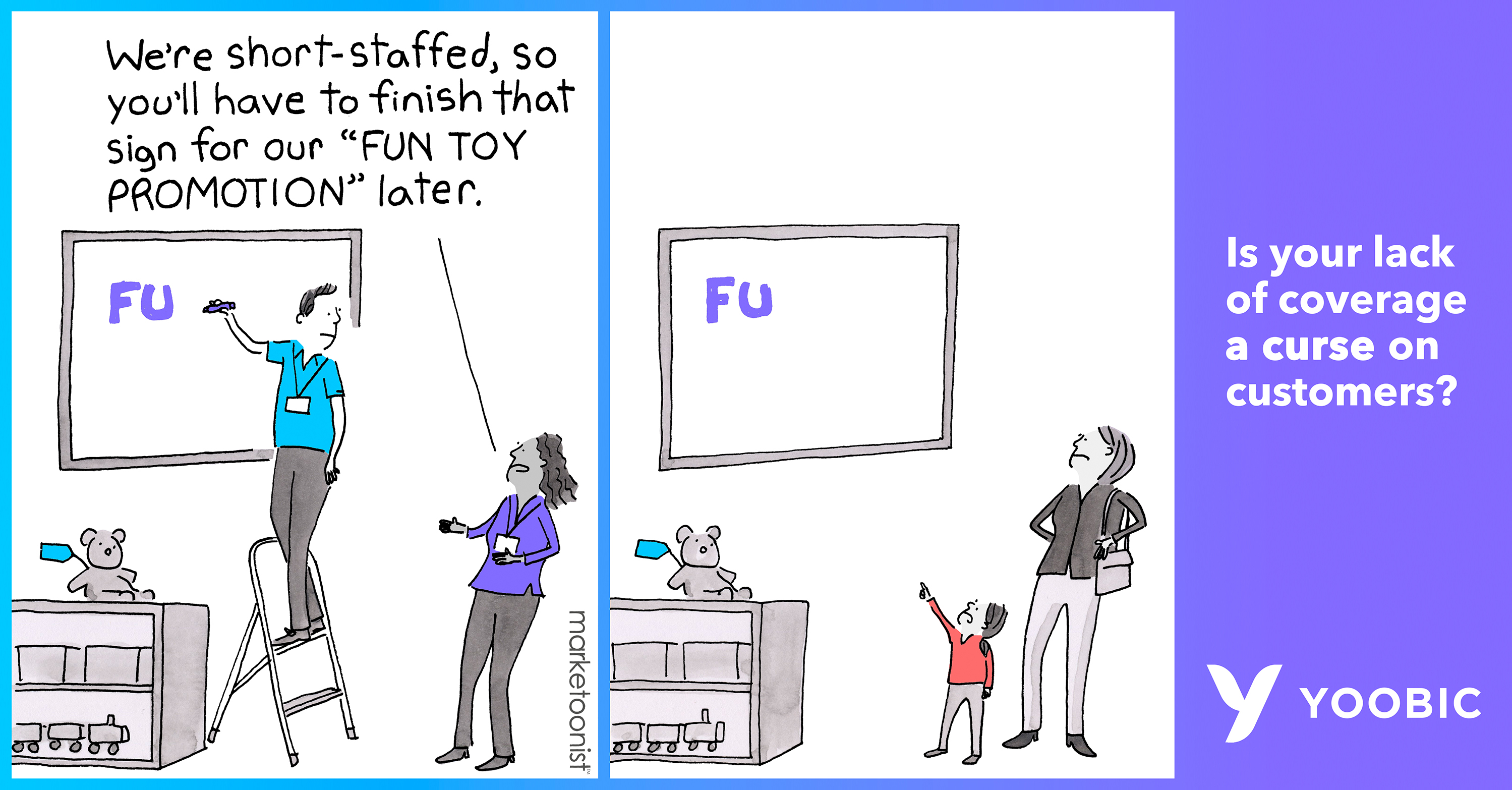Sep 1, 2022 11:53:25 AM
Training & learning | Retail | Marketoonist
Sep 1, 2022 11:53:25 AM
Training & learning | Retail | Marketoonist


The retail worker shortage. The great resignation. The big quit. Whatever you choose to call it, retailers are struggling to recruit enough workers for their stores.
A potent blend of job insecurity, burnout, and a refocusing of priorities meant that last year, approximately 4 million people handed in their notice every month.
Retail was one of the hardest-hit industries: 60% of frontline retail employees now describe their jobs as understaffed.
This hugely impacts the morale and productivity of those who stick around - 72% of frontline workers feel worn out at the end of their shift to the point that they do not enjoy their time away from work at least once a week.
In unstable and unpredictable times, retailers need to be prepared to operate with reduced resources for a while, if not indefinitely.
While retailers put in place long-term strategies to attract new talent and increase employee retention, they need to find alternative ways to adapt to operating with fewer hands on deck.
Here are 3 ways to mitigate the impacts of the retail worker shortage:
The uniquely personalized, human experience of interacting with store associates is what makes shopping in-store appealing.
Store employees need to be able to spend as much time on the shop floor as possible, especially when there’s a retail labor shortage and there are fewer workers interacting with customers in the first place.
The first step is automating time-consuming and monotonous admin tasks where possible.
Where things can’t be automated, digitize and centralize processes. Step away from excel, paper checklists, and WhatsApp - use mobile technology that centralizes all communication, information, and tasks in one place. This means employees avoid wasting time switching between platforms and searching for information.
Make priorities clear with marked deadlines that indicate which tasks can wait or be done later. Store employees shouldn’t be working through a long list of non-urgent tasks in the back office when they could be serving customers.
An ideal solution is a retail task management app as it makes priorities and task instructions clear in one, cohesive platform.
When resources are limited, you can’t afford to spend weeks, and even months getting new recruits trained up. New hires need to be up and running, being productive on the shop floor as quickly as possible.
This is why it’s time to revamp your onboarding program. Currently, 49% of frontline workers don’t think that onboarding prepared them well for their job, which means that when someone leaves, other team members will suffer as replacement hires won’t feel well-prepared to effectively contribute to the team.
A strong onboarding gets new hires up and running as quickly as possible, which reduces the strain on other team members when someone hands in their notice. Onboarding done well creates a clear learning path, equipping employees with all the basics they need to do their jobs without overwhelming them with information.
Onboarding is another opportunity to reap the benefits of a task management app, as digitized checklists and real-time feedback help new recruits to be confident that they have completed everything correctly without having to memorize the details of every process right away.
The importance of this in a retail labor shortage can’t be overstated.
For a step by step guide on how to level up your onboarding program, check out this blog: Improving Onboarding for Retail Teams: Top Tips
The long-term solution to a retail worker shortage involves addressing the reasons as to why it exists in the first place. There’s a strong correlation between employee satisfaction and the extent to which retailers invest in the employee experience.
The most common initiative employers have taken to invest in their teams has been to increase pay, but a 2022 survey found that they value other aspects almost as much as their wage, including feeling connected, valued, and supported by management.
Want to learn more about boosting retail employee engagement? Here's 5 Strategies for Mastering Engagement in Retail
Retail store employees want to feel like they are part of a supportive community, so give them the opportunity to develop this by using a communication platform that enables not only top-down, but also bottom-up and peer-to-peer communication. Give them a platform to truly connect, share knowledge and celebrate each others’ successes.
Additionally, train managers in the skill of mental health awareness so they can be strong sources of support for their frontline teams, and consider implementing initiatives which can benefit mental health, like cycle to work schemes, subsidized health care or childcare or flexible hours.
While these strategies are a great starting point to mitigating the impacts of the retail labor shortage, they are only the beginning. Want step-by-step guides explaining how to combat the retail worker shortage and make retail jobs attractive again?
We asked 1,400 frontline employees what they believe are the biggest employer pitfalls in 2022 and what their employers could do to make them want to stay. Download the survey report to discover the answers!
Search the blog

See why 350+ businesses are using YOOBIC
YOOBIC creates a better everyday working experience for frontline teams while helping businesses drive performance at scale.
PRODUCT
See why 350+ businesses are using YOOBIC
YOOBIC creates a better everyday working experience for frontline teams while helping businesses drive performance at scale.